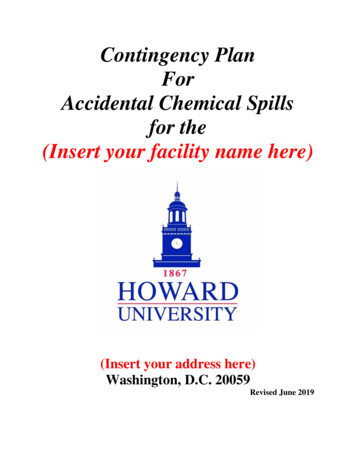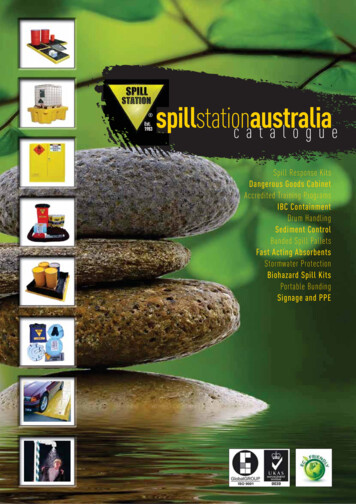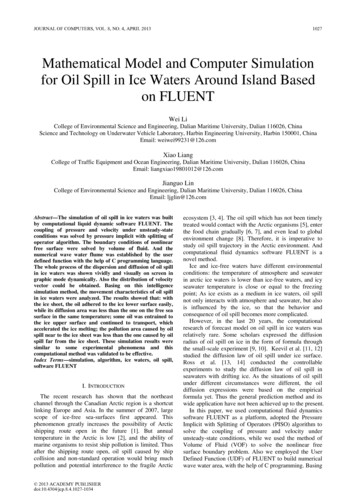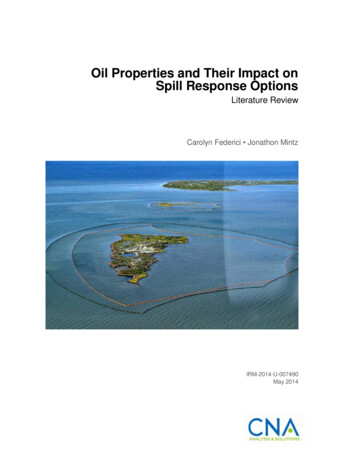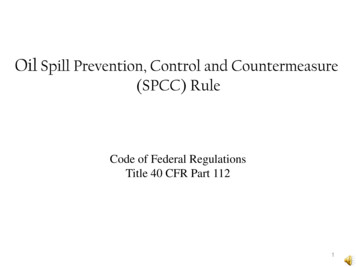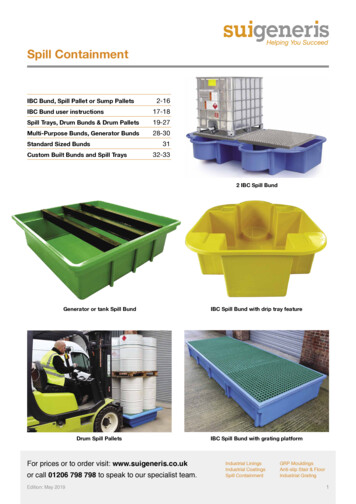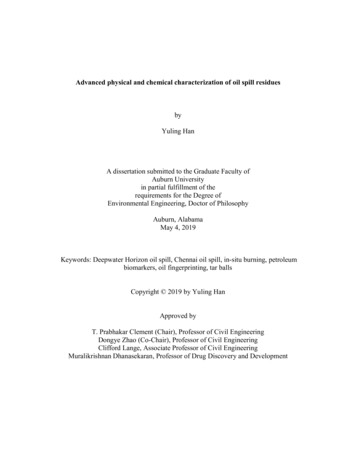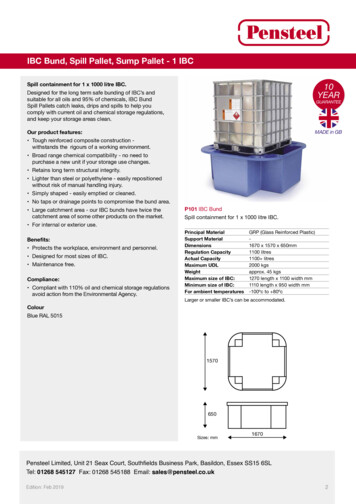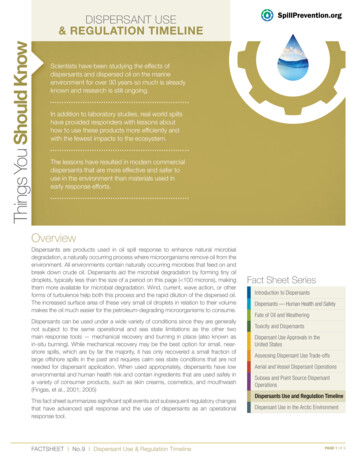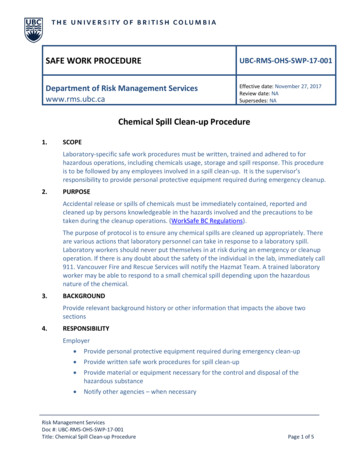
Transcription
SAFE WORK PROCEDUREUBC-RMS-OHS-SWP-17-001Department of Risk Management Serviceswww.rms.ubc.caEffective date: November 27, 2017Review date: NASupersedes: NAChemical Spill Clean-up Procedure1.SCOPELaboratory-specific safe work procedures must be written, trained and adhered to forhazardous operations, including chemicals usage, storage and spill response. This procedureis to be followed by any employees involved in a spill clean-up. It is the supervisor’sresponsibility to provide personal protective equipment required during emergency cleanup.2.PURPOSEAccidental release or spills of chemicals must be immediately contained, reported andcleaned up by persons knowledgeable in the hazards involved and the precautions to betaken during the cleanup operations. (WorkSafe BC Regulations).The purpose of protocol is to ensure any chemical spills are cleaned up appropriately. Thereare various actions that laboratory personnel can take in response to a laboratory spill.Laboratory workers should never put themselves in at risk during an emergency or cleanupoperation. If there is any doubt about the safety of the individual in the lab, immediately call911. Vancouver Fire and Rescue Services will notify the Hazmat Team. A trained laboratoryworker may be able to respond to a small chemical spill depending upon the hazardousnature of the chemical.3.BACKGROUNDProvide relevant background history or other information that impacts the above twosections4.RESPONSIBILITYEmployer Provide personal protective equipment required during emergency clean-up Provide written safe work procedures for spill clean-up Provide material or equipment necessary for the control and disposal of thehazardous substance Notify other agencies – when necessaryRisk Management ServicesDoc #: UBC-RMS-OHS-SWP-17-001Title: Chemical Spill Clean-up ProcedurePage 1 of 5
Employee5. In the event of a spill follow the instruction in the safe work procedure Report all spills on the online reporting system UBC CAIRSTRAINING REQUIREDChemical Safety Training offered by Risk Management ServicesIf appropriate equipment and trained personnel are not available on site, the area must beevacuated and emergency services called. Contact the Vancouver Fire and Rescue Servicesand Risk Management Services for support.6.MATERIALS/EQUIPMENTThe basic items to be included in a spill kit are: Spill control pillows or damming material (unreactive absorbent such as vermiculite) Acid neutralizer shaker (Spill X - A) Caustic neutralizer shaker (Spill X - C) Solvent absorber shaker (Spill X - S) pH paper Dust pan Brush PPE: safety googles and heavy duty nitrile glovesDepending on the amount and identity of chemical compounds routinely handled, there areadditional items that might be required in the spill kit. Separate safe work procedures weredeveloped for cleaning up spills of hydrofluoric acid and mercury.7.HAZARDSFor spills greater than 1 L, and for highly flammable solvents, reactive highly toxic orcorrosive materials, Vancouver Fire and Rescue Services should be called (911) for stand-bysupport.8.PROCEDURE8.1. General ProcedureOnce the risk of injuries has been mitigated, the spill may be cleaned up and the areadecontaminated using the following general procedures:1) Notify all personnel and the supervisor in the vicinity of the spill, of any flammable,highly toxic or volatile material is spilled. Evacuate and post warnings in the area asnecessary to cordon off the area and prevent harmful exposure.2) PROVIDED THE CHEMICAL SPILLED IS NOT WATER REACTIVE. If clothing has becomecontaminated, remove and enter emergency shower, if eyes have been affected,flush eyes for 15 minutes.Risk Management ServicesDoc #: UBC-RMS-OHS-SWP-17-001Title: Chemical Spill Clean-up ProcedurePage 2 of 5
3) Before responding to any spill the following information must be verified: Name of the chemical(s) involved. Approximate quantity. Hazards of the chemical (review SDS if available):o Flammability: flash point; vapor pressureo Toxicity – TLVo Corrosiveness – pH4) Perform clean-up procedures only if: The appropriate spill control material, equipment and protective clothing areavailable. Personnel are familiar with equipment and clean-up procedures. More than one person is in the lab and available to participate. Work inteams. One person cleans the spill; the other should remain outside of thecontaminated area and hand supplies to person cleaning. There are no ignition sources present.5) After reviewing the SDS and assessing the hazards posed by the spill, establish theappropriate clean-up procedure and supplies are on hand.6) Determine the extent of evacuation required.7) Gather the required equipment and materials. If the appropriate materials are notavailable, call Vancouver Fire and Rescue Services (VFRS) for assistance.8) Put on appropriate protective clothing. Minimum PPE includes lab coat, long loosefitting pants, and fully covering liquid resistant shoes. In addition, for performing aspill clean-up, medium or heavy duty rubber or nitrile gloves and safety goggles mustbe worn. Toxic, corrosive or irritating volatile materials will require the use of arespirator. Respirators must not be used without a model-specific fit test, and spillappropriate cartridges. A full-face respirator is the minimum requirement for volatileirritating, toxic or corrosive materials; if Self Contained Breathing Apparatus (SCBA) isrequired, call VFRS at 911.9) Use a spill control material (unreactive, neutral, compatible material) to make a 360degree barrier around the spill and prevent it from seeping into a drain or underfurniture or equipment.10) Wait for any neutralizing/absorbent reactions to be complete, mix the spill controlcompound with the spill, and scoop the material into an impervious container (seespecific instructions below).11) Wash the affected area and PPE with an appropriate cleaning solution (soap andwater).12) Arrange for pick-up of the waste material by the Environmental Services Facility (ESF)at 604-822-1285 or 604-323-4420Risk Management ServicesDoc #: UBC-RMS-OHS-SWP-17-001Title: Chemical Spill Clean-up ProcedurePage 3 of 5
13) Report the incident on the online reporting system UBC CAIRS.8.2. Cleaning a flammable solvent spillNote: Never attempt to clean up a solvent spill if an ignition source is present1) Contain the spill to prevent it from spreading by using unreactive, neutral,compatible material (e.g. kitty litter, absorbent socks, or pads etc.) to create a barrieraround the spill.2) Apply solvent absorbent (Spill X-S, Solusorb or equivalent product) from theperimeter inward, covering the total spill area.3) Mix thoroughly with plastic spatulas until material is dry and free flowing, and noevidence of free liquid remains.4) Transfer the absorbed solvent to an appropriate disposal container that is not solublein the solvent, and seal the container.5) Contact the ESF at 604-822-1285 or 604-323-4420 for directions concerning disposalof the container and its contents.Procedure is complete, method of disposal and expectation of general housekeeping isdetailed8.3. Cleaning an acid spillExcept hydrofluoric acid and perchloric acid – these acids require specialized handlingpractices1) Contain the spill to prevent it from spreading by using an unreactive, neutral,compatible material (e.g. kitty litter, absorbent socks, or pads etc.) to create a barrieraround the spill.2) Apply acid neutralizer (Spill X-A, Neutrasorb or equivalent product) gently to the spill.3) Carefully mix with a plastic spatula or other tool, working towards the spill center tominimize spread.4) When foaming subsides, check pH with pH paper (e.g. E.M. Quant Company availablefrom BDH or Anachemia Science).5) If pH is less than pH 6, add more neutralizer to any free acid and repeat step 3 and 4;if spill pH is greater than pH 8 add a caustic neutralizer (Spill X-C or equivalent). Thetarget range is pH 6 to 8.6) When the spill has been sufficiently neutralized, pick up treated material with scoops,dust pan, broom, and transfer to a disposal container.7) Seal and label container.8) Decontaminate and wash spill site surfaces with soapy water and wet sponge.9) Contact the ESF at 604-822-1285 or 604-323-4420 for directions concerning disposalof the bag and its contents.Risk Management ServicesDoc #: UBC-RMS-OHS-SWP-17-001Title: Chemical Spill Clean-up ProcedurePage 4 of 5
8.4. Caustic1) Contain the spill to prevent it from spreading by using unreactive, neutral,compatible material (eg. kitty litter, absorbent socks, or pads etc.) to create a barrieraround the spill.2) Gently apply neutralizer for caustics (Spill X-C, Neutracit-2 or equivalent product) tothe spill, working inwards.3) Carefully mix with a plastic spatula or other tool;4) When foaming subsides, check pH with pH paper (e.g. E.M. Quant Companyavailable from BDH or Anachemia Science).5) If pH is greater than 8, add more neutralizer to any free base and repeat step 3 and4; if pH is less than 6, add acid neutralizer and repeat step 3 and 4. The target rangeis pH 6 to 8.6) When the spill has been sufficiently neutralized, pick up treated material withscoops, dust pan, broom and transfer to a disposal container.7) Seal and label container.8) Decontaminate and wash spill area surfaces with water and wet sponge.9) Check with the ESF at 604-822-1285 or 604-323-4420 for directions concerningdisposal of the bag and contents.9.OTHER IMPORTANT INFORMATION – CALLING FOR ASSISTANCEWhen placing a call to 911 or the Hazmat Team, provide the operator with:a) Your name and phone extension.b) Exact location of spill (building and room number).c) Name of material spilled.d) Quantity of material spilled.e) Information on injuries to personnelOff-campus locations, such as hospital sites, may have different phone numbers andprotocols.10.REVIEW AND RETENTIONThis SWP is reviewed annually or whenever deemed necessary by the responsibledepartmental representative in Risk Management Services.11.DOCUMENT INFORMATIONWritten / Reviewed by:Contact:Risk Management ServicesDoc #: UBC-RMS-OHS-SWP-17-001Title: Chemical Spill Clean-up ProcedureRMS Advisor, Chemical Safetyresearchsafety@rms.ubc.ca604-827-3409Page 5 of 5
Title: Chemical Spill Clean-up Procedure Page 1 of 5 Chemical Spill Clean-up Procedure 1. SCOPE Laboratory-specific safe work procedures must be written, trained and adhered to for hazardous operations, including chemicals usage, storage and spill response. This procedure is to be followed by any employees involved in a spill clean-up.
